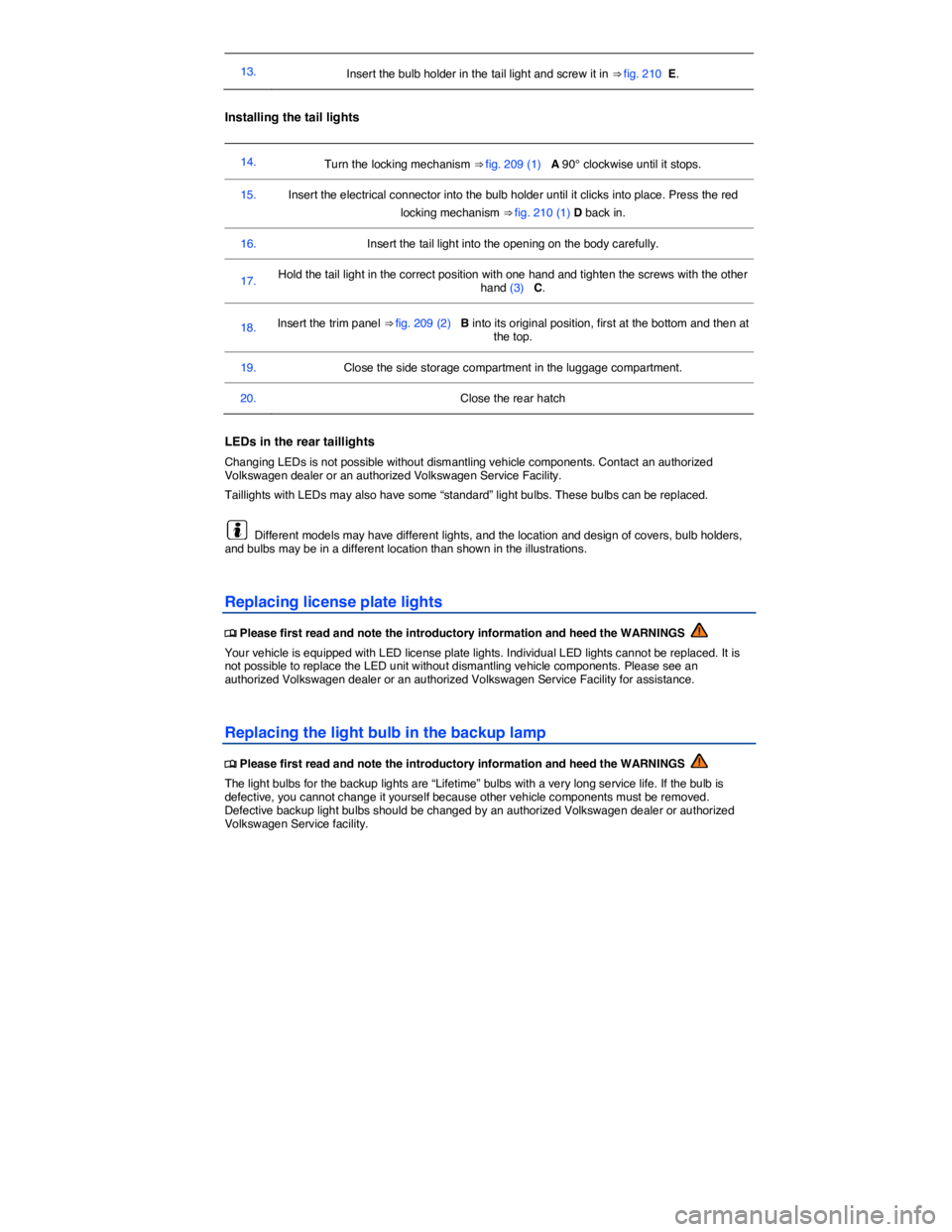Page 421 of 435

13. Insert the bulb holder in the tail light and screw it in ⇒ fig. 210 E.
Installing the tail lights
14. Turn the locking mechanism ⇒ fig. 209 (1) A 90° clockwise until it stops.
15. Insert the electrical connector into the bulb holder until it clicks into place. Press the red
locking mechanism ⇒ fig. 210 (1) D back in.
16. Insert the tail light into the opening on the body carefully.
17. Hold the tail light in the correct position with one hand and tighten the screws with the other hand (3) C.
18. Insert the trim panel ⇒ fig. 209 (2) B into its original position, first at the bottom and then at the top.
19. Close the side storage compartment in the luggage compartment.
20. Close the rear hatch
LEDs in the rear taillights
Changing LEDs is not possible without dismantling vehicle components. Contact an authorized Volkswagen dealer or an authorized Volkswagen Service Facility.
Taillights with LEDs may also have some “standard” light bulbs. These bulbs can be replaced.
Different models may have different lights, and the location and design of covers, bulb holders, and bulbs may be in a different location than shown in the illustrations.
Replacing license plate lights
�
Page 425 of 435

Before removing the jumper cables
1. Switch off the headlights (if they are on).
2. In the vehicle with the dead battery, switch on the heater fan and the rear window defroster. This helps to minimize voltage spikes when the cables are disconnected.
Removing jumper cables
With the engine running, remove the jumper cables in reverse order to the way they were connected.
1. Disconnect the black (-) cable from the vehicle with the dead battery.
2. Disconnect the black (–) cable from the other vehicle (vehicle with the good battery).
3. Disconnect the red (+) cable from the other vehicle (vehicle with the good battery).
4. Disconnect the red (+) cable from the vehicle with the dead battery.
5. Close the battery cover as the case may be.
WARNING
Improper use of jumper cables when jump-starting a vehicle with a dead battery can cause the battery to explode, leading to serious personal injury. To help reduce the risk of battery explosion:
�x All work on the batteries or the electrical system in your vehicle can cause serious acid burns, fires, or electrical shocks. Always read and heed the following WARNINGS and safety
precautions before working on the batteries or the electrical system ⇒ 12 Volt vehicle battery.
�x Always wear proper eye protection. Never lean over the vehicle batteries.
�x Attach the jumper cables in the correct order: first the positive cable, then the negative cable.
�x Never connect the negative cable from the vehicle providing starting assistance to parts of the fuel system or to the brake hoses or brake lines.
�x Never allow the non-insulated parts of the battery clamps to touch.
�x Never allow the jumper cable attached to the positive battery terminal to contact metal parts of the vehicle.
�x Check the battery acid level indicator window on the vehicle battery. Use a flashlight, never a match, cigarette lighter, or other open flame. If you cannot see the color of the window clearly, or if it is light yellow or colorless, do not jump-start the vehicle. Get expert assistance.
�x Avoid electrostatic discharge in the vicinity of the vehicle battery. Sparks may cause the hydrogen gas escaping from the vehicle battery to ignite.
�x Never jump-start a vehicle with a battery that is damaged or frozen or that was frozen and has thawed. The battery can explode. Replace the battery instead.
�x Always follow the instructions of the jumper cable manufacturer.
�x Always make sure that the battery providing starting assistance has the same voltage as the dead battery (12 V) and about the same capacity (see battery label).
�x Batteries give off explosive hydrogen gas. Always keep fire, sparks, open flame and smoking materials away from batteries.
�x Never connect the negative cable from the other vehicle directly to the negative terminal of the dead battery. The hydrogen gas from the battery is explosive.
�x Never short out the battery terminals by connecting the positive (+) and negative (–) terminals with each other.
Page 434 of 435

Abbreviations
Abbreviation Meaning
5S manual 5-speed manual transmission
6S automatic 6-speed automatic transmission
6S manual 6-speed manual transmission
ABS Anti-lock Brake System
AFS Adaptive Front Lighting System
AKI Anti-Knock Index
ANSI American National Standards Institute
ASL Automatic Shift Lock
ASR Anti-Slip Regulation
ATA Anti-Theft Alarm system
BAS Brake Assist System
ccm Cubic centimeter unit of volume for specifying engine displacement
CCS Cruise control
CID Cubic inch displacement, unit of volume for specifying engine displacement
cm Centimeter – metric unit of measure for length
CO2 Carbon dioxide
DIN Deutsches Institut für Normung (German Institute for Standardization)
DRL Daytime running lights
EDL Electronic Differential Lock
EDR Event Data Recorder
EN European Norm
EPC Engine control (Electronic Power Control)
ESC Electronic Stability Control
g/mi (g/km) Generated carbon monoxide amount in grams per mile (kilometer) driven
GAWR Gross Axle Weight Rating
GVWR Gross Vehicle Weight Rating
HID High Intensity Discharge headlights (HID)
hp Horsepower, unit used to rate engine power
kg Kilogram – metric unit for weight
kN Kilonewton, a measure of force
kp Kilopond, a measure of force
kW Kilowatt, engine rating
LED Light Emitting Diode
m Meter – metric unit of measure for length